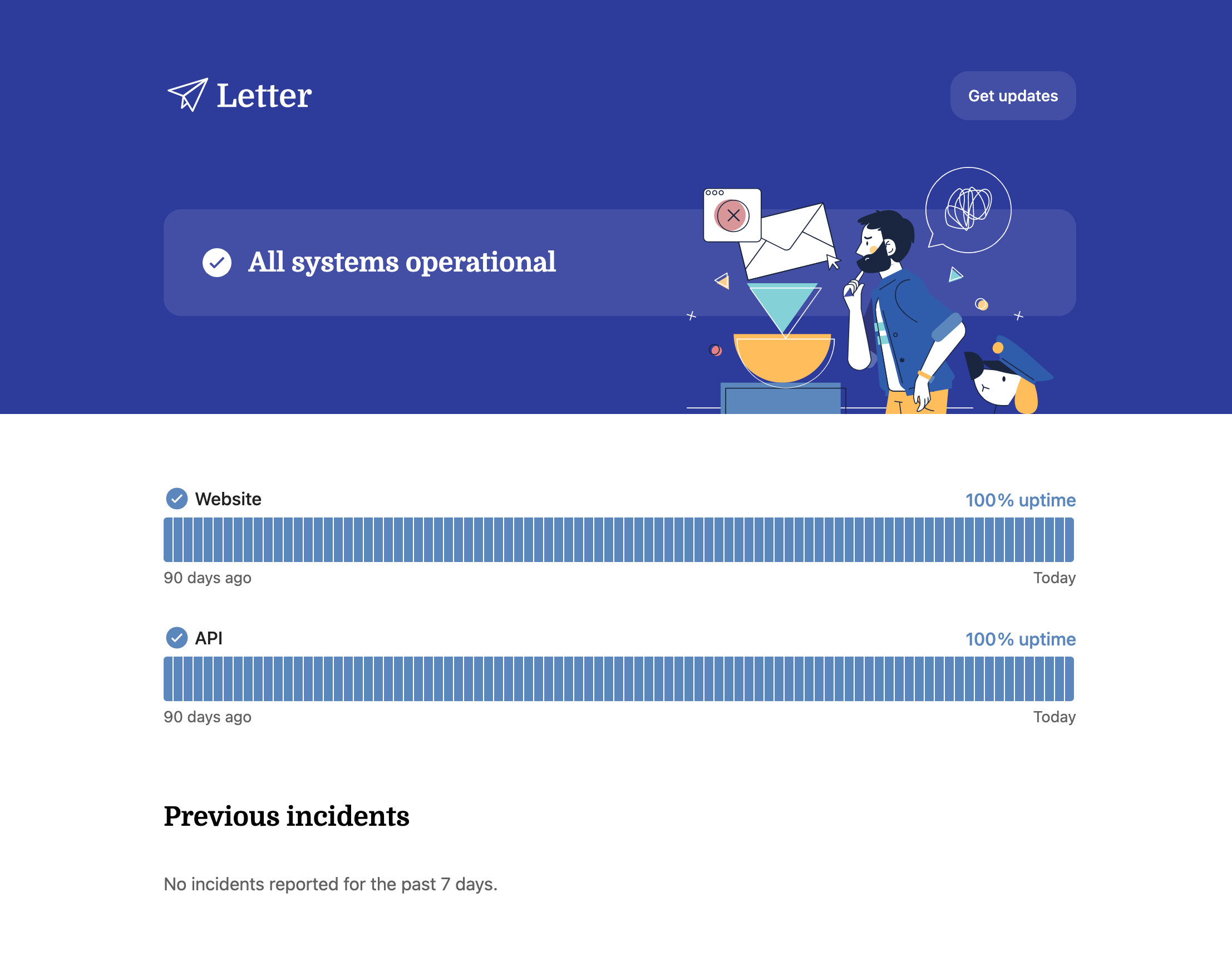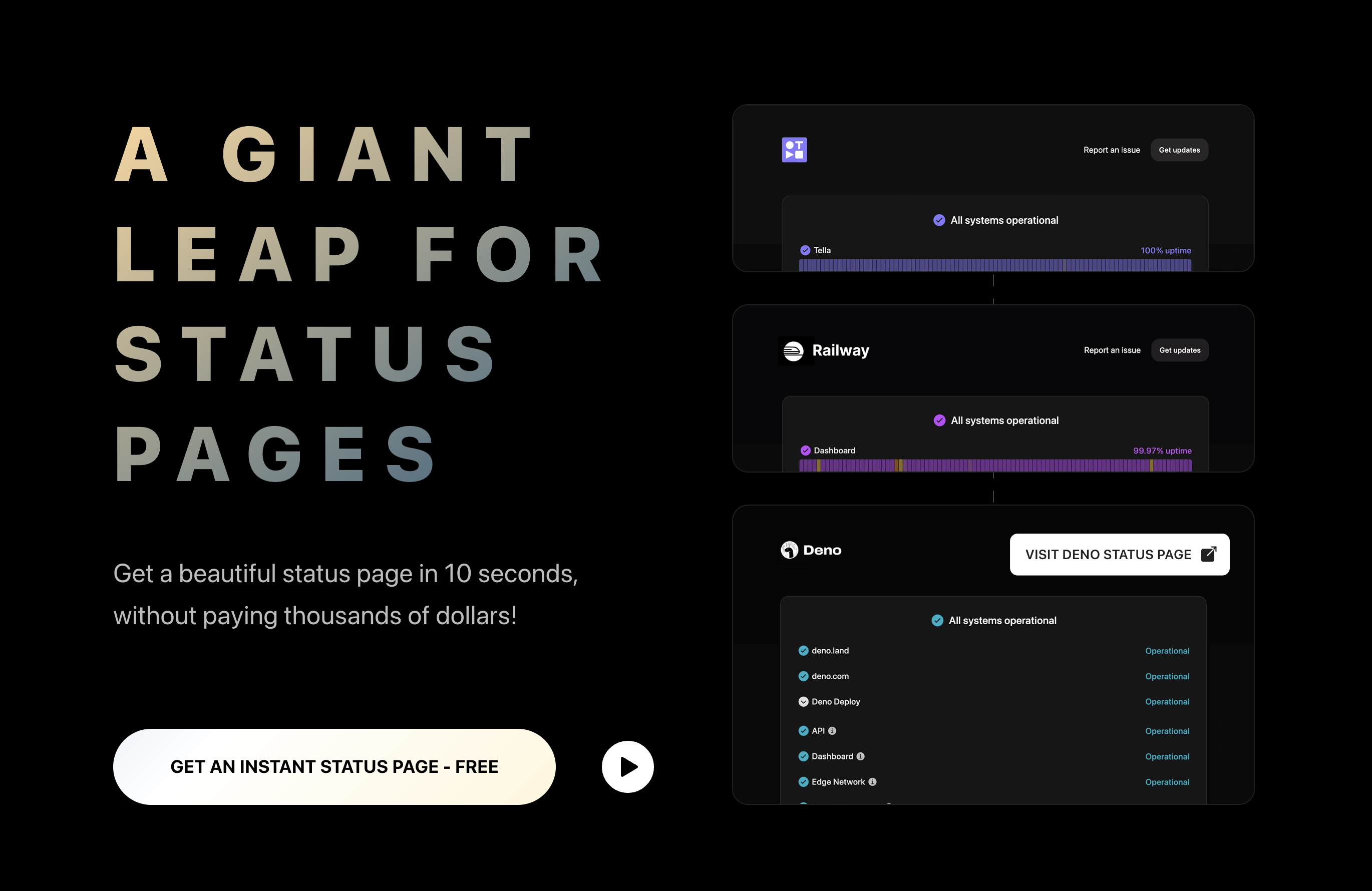Here’s How Complete Guide to On-Call Scheduling

Helpful Summary
- Overview: The article explains how to set up an on-call schedule that works for your business, why you should invest time into on-call scheduling, and its benefits.
- Why you can trust us: Instatus has been instrumental in propelling top brands such as Wistia, Deno, Dovetail, and numerous others to unparalleled success. Our monitoring tools are reliable and dependable because we schedule our employees with care to ensure that someone is always online and ready to help our customers.
- Why it matters: Properly implemented on-call scheduling ensures that incidents are addressed promptly, minimizing downtime and maintaining service reliability. It fairly distributes the workload to prevent burnout and improve team performance.
- Action points: Learn the fundamentals of a well-crafted on-call schedule that benefits the organization and the employees.
- Further research: Check out our blogs for more insights into incident management, smooth communication, and real-time alerts and notifications.
Why Do You Need A Balanced On-Call Schedule?
What’s the funny thing about incidents? They never happen at the right time. Often, they strike when you’re short-staffed or your staff is spread too thin. How can you ensure there’s always someone at the helm in case disaster strikes?
The answer is on-call scheduling to ensure staff can be available on short notice to deal with emergencies. Historically, on-call schedules and rotations have had a bad reputation due to a lack of flexibility, but those issues can be easily solved with a bit of organization.
On-call scheduling can be properly implemented to balance the needs of your staff and the needs of your customers.
For example, a well-balanced on-call schedule could entail rotating five team members to cover one weekday per week, with weekend rotations occurring every five weeks to prevent consecutive weekend duties. Shifts are restricted to 24 hours, ensuring fair distribution and ample rest for all team members.
Fairly distributing on-call duties and balancing workloads prevent employee burnout, keep the team motivated, and improve response times and decision-making.
So, how do you go about creating an employee schedule that works for everyone? This Instatus article will delve into the nitty-gritty of all this and more. Let's get started!
Why Listen to Us?
We've collaborated with several leading companies, such as Podium, Restream, Railway, and others, offering them high-quality solutions for incident management, website monitoring, and API monitoring.
Our fully customizable status pages convey the situation to clients and stakeholders, boosting customer satisfaction and ensuring stakeholders are aware of any incidents.
We help with on-call scheduling by providing integrated features that increase uptime, enhance overall incident management, and improve the responsiveness of support teams. We ensure that the right individuals are notified in real-time when an issue crops up.
This seamless integration simplifies the hassle of manually managing on-call schedules and guarantees that alerts are dispatched to the right team members according to the schedule.
What is an On-Call Schedule?
A properly implemented on-call schedule involves crafting a carefully outlined plan that designates specific team members to address incidents or emergencies outside standard working hours.
Having an on-call schedule in place ensures that someone is always ready to tackle urgent issues, day or night, minimizing downtime and maintaining system reliability. The schedule typically rotates among team members to evenly distribute the workload and prevent burnout, with specific shifts assigned to cover nights, weekends, and holidays.
The importance of a well-thought-out and properly implemented on-call schedule cannot be overstated. Organizations need it for swift incident resolution and service continuity, especially in environments that require 24/7 availability.
Industries That Use On-Call Schedules
On-call scheduling is widely used in many sectors to ensure operational flexibility and timely response to unforeseen demands. Here are some of the industries that use on-call scheduling:
- Healthcare (hospitals and medical facilities)
- IT and software development (support teams and software engineers)
- Utilities and infrastructure (electricity, gas, water, etc. providers)
- Public safety and emergency services (police, firefighters, etc.)
- Telecommunications (network engineers and support staff)
- Manufacturing and retail operations (maintenance teams)
Nearly all professional practices implement on-call scheduling. For example, on-call doctors must be ready to respond to emergencies anytime during their shifts.
Similarly, IT and development professionals rely on on-call schedules to ensure there's always a hero ready to tackle significant bugs, capacity issues, or product downtime. It's all about being there to save the day or call in reinforcements if the problem is beyond their capabilities.
Benefits of On-Call Schedules
On-call schedules offer significant benefits for organizations and employees. Let's delve into these advantages in detail.
For Employers
- A 24/7 coverage schedule ensures that critical systems and services are monitored and supported around the clock. This reduces downtime and maintains business continuity. Access to staff and expertise exactly when needed is vital, especially in emergency services.
- On-call scheduling saves operational costs by eliminating the need for a full-time night shift or dedicated 24/7 staff. Having on-call employees ensures that staff only work when needed, which reduces labor costs.
- Quick identification and prompt resolution of issues are essential for minimizing their impact on business operations and reducing potential downtime.
- To build and maintain customer trust, you must respond promptly to incidents and uphold high service standards. Swiftly addressing emergencies, critical situations, and spikes in demand allows businesses to deliver superior products, enhancing overall service reliability.
For Employees
-
On-call shifts provide employees with valuable flexibility, enabling a better balance between personal and professional responsibilities. On-call staff are not always required, resulting in fewer work hours and the ability to arrange work schedules more flexibly.
-
Employees knowing when they will be on-call decreases their anxiety about being caught off guard by an issue and avoids them feeling like they’re not supporting their team.
-
Being on-call offers invaluable real-world experience, allowing employees to handle critical incidents adeptly. It strengthens their problem-solving abilities and technical expertise.
-
Many organizations sweeten the deal for on-call duties by offering extra pay, bonuses, or time off. It's their way of saying "thank you" for being available anytime duty calls.
Factors To Consider When Creating On-Call Schedules
When creating on-call schedules, several factors should be considered to ensure they work for the organization and its employees.
Team Size and Skill Set
Consider the number of team members available and their expertise. This ensures the on-call rotation is manageable and qualified personnel are always available to handle incidents.
The perfect schedule for a two-person startup team is different than the ideal schedule for a team of 100. Teams of two can alternate workdays, while teams of three or more might find that switching up schedules every week is the best approach.
Take the time to consider what works best for your business.
Workload Distribution & Backup
Ensure the schedule distributes on-call duties evenly among team members to prevent burnout and fatigue. Avoid overloading any single employee with excessive on-call responsibilities. Having at least one backup person available on call is a prudent strategy.
In a two-person team, there's always someone on call and someone serving as the backup. When the team expands to three people, you can add a third layer to your backup plans or designate one person off-duty at any given time.
Geographic Considerations
Take account of time zones and locations when working with teams spread across different locations. This helps minimize disruptions and ensures that team coverage is aligned with what works for your employees.
A popular model of on-call scheduling is “follow-the-sun,” which involves scheduling on-call rotations during daylight hours. This approach is highly beneficial because it promotes improved work-life balance and addresses employee worries about being disturbed in the middle of the night.
It's particularly ideal for remote teams with members spread across large geographic regions.
Availability and Preferences
To create a more flexible and accommodating schedule, consider team members' personal preferences, availability, and potential constraints, such as family commitments or other responsibilities.
For instance, a 4:00 a.m. to 11:00 a.m. schedule might work well if you’re a morning person. On the other hand, if you're a night owl, you might prefer working from 9:00 p.m. to 4:00 a.m.
Frequency and Duration of Shifts
Carefully plan the schedule for on-call shifts to ensure employees have enough time to rest and recover between shifts. It's essential to strike a balance between providing sufficient coverage and ensuring that employees don't work excessively long or frequent shifts, which could lead to exhaustion and burnout.
Communication and Tools
Ensure that on-call employees have full access to the essential tools, detailed documentation, and reliable communication channels needed to manage and resolve any incidents.
Compliance and Legal Requirements
Comply with labor laws and regulations concerning the number of working hours, breaks, and fair compensation for on-call responsibilities to prevent legal complications and guarantee equitable treatment.
How To Create An Efficient On-Call Schedule
Creating an efficient and balanced on-call schedule involves careful planning to ensure balanced workloads, quick incident response, and minimal burnout.
Define Clear Expectations
Delineate your organization's specific roles, responsibilities, and expectations for on-call duties. It should clarify the expected response times and outline the procedures for escalating issues.
As the meaning of "on call" can vary across businesses, your company must provide an unambiguous definition to ensure that employees are fully informed about their obligations.
Ensure Fair Rotation & Scheduling
See to it that everyone on the team has a fair share of on-call shifts to prevent burnout and maintain a healthy workload distribution.
While drafting your on-call schedule, try to avoid the night shift whenever possible. Contact employees in the evening for critical issues only. This allows them to rest and be productive the next day while remaining available for emergencies.
Use a Reliable Scheduling Tool
Maximize efficiency by availing scheduling software or tools to automate on-call rotations, streamline shift management, and facilitate seamless schedule adjustments or swaps.
With its intuitive interface and integration capabilities, Instatus improves overall incident response and team coordination for on-call staff. It provides clear status updates and smooth communication during outages, allowing for quick response and successful management of on-call duties.
Plan for Overlapping & Employee Preferences
Scheduling shifts with some overlap is necessary to ensure smooth transitions and uninterrupted coverage during the handoff from one on-call employee to another.
Prioritize honoring each employee’s shift preferences and time-off requests whenever you can. It demonstrates your commitment to their well-being and builds a strong sense of teamwork. You’ll be able to boost employee engagement and satisfaction, ultimately leading to higher retention rates.
Incorporate Flexibility & Exercise Prudence
Allow your team members to swap shifts or request time off, enabling them to manage their schedules better and alleviate unnecessary stress.
Build your on-call schedule around team members' capabilities. For a quick reference, keep a list of their strengths, such as efficiency, coordination skills, experience, customer service proficiency, etc.
Monitor and Adjust the Schedule
Conduct regular assessments of the on-call schedule to gauge its impact and make necessary adjustments based on the team's feedback and the data from incident responses.
If you notice signs of burnout among your team members, amend the scheduling practices that endorse a more favorable work-life balance.
Observe Fully Functioning On-Call Scheduling With Instatus
On-call scheduling ensures fair workload distribution and swift response to incidents, decreasing burnout and improving system reliability. It relies on clear communication, automation tools, and regular feedback to optimize team performance.
This is where Instatus is the perfect fit. We provide automated tools to streamline the incident response process by providing a reliable platform for real-time alerts and updates, a user-friendly interface, and robust integration capabilities. When on-call staff need to communicate with each other and need the most current information about their site, Instatus is there to provide everything they need.
Create your account today to improve communication, foster better teamwork, and ensure a more efficient and responsive approach to maintaining service continuity.
Get ready for downtime
Monitor your services
Fix incidents with your team
Share your status with customers






